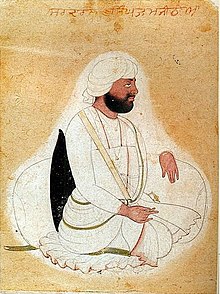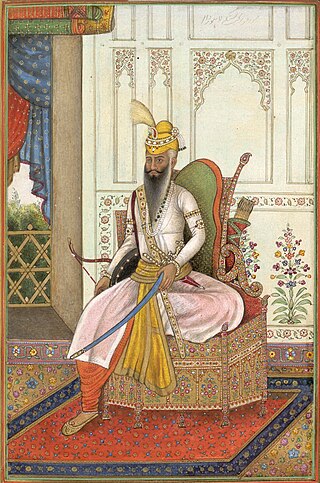
Ranjit Singh, popularly known as Sher-e-Punjab or "Lion of Punjab", was the first Maharaja of the Sikh Empire, which ruled the northwest Indian subcontinent in the early half of the 19th century. He survived smallpox in infancy but lost sight in his left eye. He fought his first battle alongside his father at age 10. After his father died around Ranjit's early teenage years, Ranjit subsequently fought several wars to expel the Afghans throughout his teenage years. At the age of 21, he was proclaimed the "Maharaja of Punjab". His empire grew in the Punjab region under his leadership through 1839.

Diwan Dina Nath (1795—1857), was an official of the durbar (court) of the Sikh Empire, whom served as the privy seal and finance minister, and later was conferred the title of Raja by Maharaja Ranjit Singh.
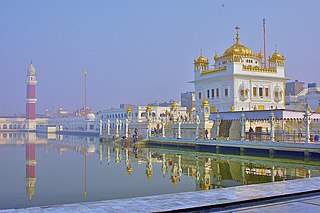
Gurdwara Sri Tarn Taran Sahib is a gurdwara established by the fifth guru, Guru Arjan Dev, in the city of Tarn Taran Sahib, Punjab, India. The site has the distinction of having the largest sarovar of all the gurdwaras. It is famous for the monthly gathering of pilgrims on the day of Amavas. It is near Harmandir Sahib, Amritsar.

Majha is a region located in the central parts of the historical Punjab region split between India and Pakistan. It extends north from the right banks of the river Beas, and reaches as far north as the river Jhelum. People of the Majha region are given the demonym "Mājhī" or "Majhail". Most inhabitants of the region speak the Majhi dialect, which is the basis of the standard register of the Punjabi language. The most populous city in the area is Lahore on the Pakistani side, and Amritsar on the Indian side of the border.

Khalsa College is a historic educational institution in the northern Indian city of Amritsar in the state of Punjab, India. Founded in 1892, the sprawling 300-acre (1.2 km2) campus is located about eight kilometers from the city-center on the Amritsar-Lahore highway, adjoining Guru Nanak Dev University campus, to which Khalsa College is academically affiliated.
Majitha is a town and a municipal council in Amritsar district in the Indian state of Punjab. The 2011 Census of India recorded 14,503 people resident in the town.

The Majithia family, are a family of Shergill Jat sardars (chiefs) that originate from the region of Majitha in the Punjab.
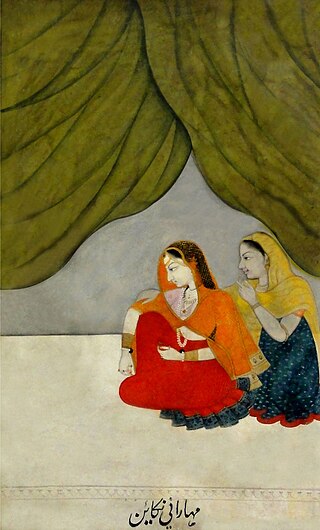
Maharani Datar Kaur (born Bibi Raj Kaur Nakai; was the queen consort of Maharaja Ranjit Singh, the founder of the Sikh Empire and the mother of his successor, Maharaja Kharak Singh. She was the daughter of Sardar Ran Singh Nakai, third ruler of the Nakai Misl and Sardarni Karmo Kaur.
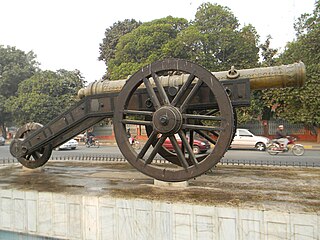
The Zamzama Gun also known as Kim’s Gun or Bhangianwali Toap is a large-bore cannon. It was cast in about 1757 in Lahore during the Durrani Empire. It is currently on display in front of the Lahore Museum in Lahore, Pakistan.
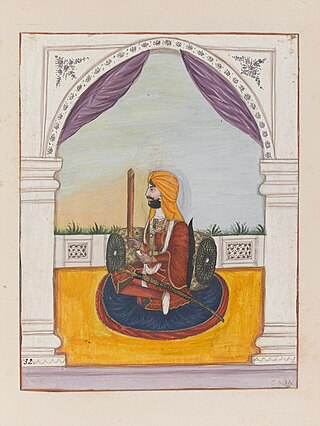
Ranjodh Singh was a powerful member of the Sikh aristocracy and governor of Hazara. The Majithia family are Jat of the Shergill gotra (clan), and were particularly influential in the area near their headquarters in Majithia.
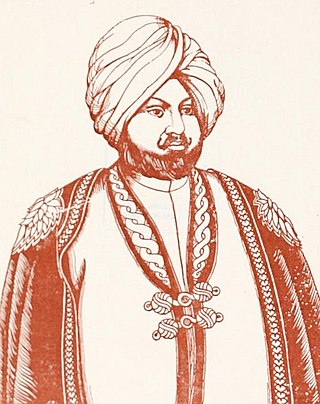
Sardar Dyal Singh Majithia (1848–1898) was an Indian banker and activist in progressive and social reform measures in Punjab. He established The Tribune English language newspaper in Lahore in 1881, and later remained founder chairman of the Punjab National Bank, established in 1894. Dyal Singh trust also donated many acres of land to the school.

The Bhangi Misl was a large and powerful Sikh Misl headquartered in Amritsar. It was founded in the early 18th century by Sardar Chhajja Singh Dhillon, who was baptised by Banda Singh Bahadur. The misl received its name "Bhangi" because Chhajja Singh and his soldiers frequently used the herbal intoxicant bhang. It was a first misl to established a Khalsa Raj and publish Khalsa currency coins. The Bhangi Kingdom/Misl was founded by Dhillon Jats.

Sardar Gujjar Singh Bhangi was a Sikh warrior of the Bhangi Misl, and one of the triumvirates who ruled over Lahore prior to the leadership of Maharaja Ranjit Singh.

Akali Phula Singh Nihang was an Akali Nihang Sikh leader. He was a saint soldier of the Khalsa Shaheedan Misl and head of the Budha Dal in the early 19th century. He was also a senior general in the Sikh Khalsa Army and commander of the irregular Nihang of the army. He played a role in uniting Sikh misls in Amritsar. He was not afraid of the British who at many times ordered for his arrest but were not successful. During his later years he served for the Sikh Empire as a direct adviser to Maharaja Ranjit Singh. He remained an army general in many famous Sikh battles up until his martyrdom in the battle of Nowshera. He was admired by the local people and had a great influence over the land and his settlement was always open to help the poor and helpless. He was well known and was a humble unique leader and prestigious warrior with high character. He was also known for his effort to maintain the values of Gurmat and the Khalsa panth.
Sobha Singh Kanhaiya of Niazbeg, his first name is alternatively spelt as Suba or Soba, was one of the triumvirates who ruled over Lahore, alongside sardars Lehna Singh Kahlon and Gujjar Singh of the Bhangi Misl, prior to the leadership of Maharaja Ranjit Singh.
Manawala is a city in Sheikhupura District, Punjab, Pakistan. It is situated on the Lahore-Sheikhupura-Faisalabad road.
Sardar Kahan Singh Nakai was the sixth and the last chief of the Nakai Misl. He was the grandson of the famous Sikh chief, Ran Singh Nakai and Sardarni Karmo Kaur. His aunt, Maharani Datar Kaur was the wife of Maharaja Ranjit Singh, founder of the Sikh Empire; thus making him the nephew of the Sher-e-Punjab. From an early age he assisted his father in campaigns and even commanded campaigns assigned to him by his uncle, Maharaja Ranjit Singh. His cousin, Kharak Singh went to become the second Maharaja of the Sikh Empire. He was the uncle of the third Maharaja, Nau Nihal Singh.
Sultan Mahmud Khan was a commander of the Sikh Khalsa Army, the army of Sarkar e Khalsa. His derah of artillery was designated as Topkhana Sultan Mahmud. He is regarded as one of the best commanding officers of Maharaja Ranjit Singh.
Mughalchak is a town in Gujranwala District, Punjab, Pakistan.
The Siege of Lahore took place in early 1800 and spanned two months. It was a coalition response by Bhangi Sardars and Nawab Nizam-ud-Din Khan of Kasur against Ranjit Singh's expanding influence, supported by Rani Sada Kaur. The siege ended with the death of Gulab Singh Bhangi due to excessive drinking. The Bhangi and Pashtun forces then lifted the siege and retreated.
